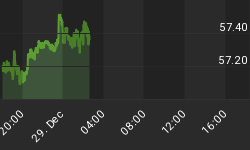With gold recouping some losses in its most recent trading sessions, many are asking whether or not the bottom has finally formed for the yellow metal. Most of these gains have been simply chalked up to short-covering and dovish remarks by Bernanke during the recent Federal Open Market Committee meetings; however, there are some key indicators for gold which are overshadowed by the media hubbub. Two of them in particular are important to understand, because they reveal a renewed investment demand for physical gold over paper gold or fiat currencies.
Gold Backwardation
The first indicator to note is called "gold backwardation," which occurs "when the price of a futures contract is lower than the price in the spot market."[1] This means that traders are willing to pay more for gold that is available for delivery today, rather than lock in a futures contract at a discount for gold that is delivered months later.
Taking this one step further, if gold stays in backwardation for some time, it means that no one is taking advantage of a risk-free arbitrage opportunity by simultaneously selling physical gold at spot and buying a futures contract. In such a scenario, traders can keep not only the spread between the spot rate and the futures rate, but also their original position in gold. This is known as "de-carrying gold." Now, if enough traders were to take advantage of this risk-free profit, gold would be pushed out of backwardation into its normal trading state (i.e., "contango," when the price of a futures contract is higher than the physical spot price). The fact that this is not occurring, and that gold remains in backwardation, implies that gold is more and more decoupling from the dollar - a trend that, if continued, could raise the dollar price of gold and other assets significantly.[1]
Backwardation is quite common in other commodities like crude oil or copper, but in gold and even silver it should be exceedingly rare. Why? Because unlike the aforementioned commodities, the above-ground inventories of precious metals are mostly not consumed - they simply trade hands. Therefore, a sudden shortage of gold is not likely - it gains value by staying stable while currencies depreciate. Nonetheless, when gold does go into backwardation, it signals that there is not enough gold for sale to meet market demand. In other words, gold becomes "scarce."
This is precisely what is happening with gold now, and has been happening intermittently since 2008. Yet more recently, gold has been going further into backwardation (deeper spreads) and staying there longer (longer contract times).
GOFO Rate
The second important indicator of the demand for gold is a negative Gold Offered Forward, or "GOFO," rate.
"GOFO is calculated by subtracting the gold lease rate from the London Interbank Offered Rate [LIBOR], the average rate banks charge each other for loans. Note that normally, given the positive GOFO rate, people will employ gold to get their hands on dollars. In other words, gold is normally used as collateral to secure a dollar loan with interest."[2]
But what happens when the rate goes negative? A negative GOFO rate means that traders would rather give up dollars in order to secure gold bullion immediately and are willing to pay an interest rate to do so. Similar to gold backwardation, a negative GOFO rate signals that the demand for gold is overwhelming the available supply.
A Replay of 2008
So what's the big deal? Why are these somewhat obscure signs so important? There are at least two reasons you should pay attention.
First, there is history. The last time we saw gold in backwardation and a negative GOFO rate was in 2008, right before gold went into its largest and longest rally - setting record highs.
Keep in mind that the broader macro-economic factors that were instrumental in the financial crisis of 2008 (bailouts, aggressive bond-buying programs, and suppressed interest rates) have not dissipated at all, but rather increased. The Fed has maintained a relentless inflationary program since 2008 (QEI, II, III, and so on). This strongly indicates that what lies ahead for gold could potentially dwarf its post-2008 rally.
Second, the negative GOFO rate and backwardation of gold are important because they represent a clear measure of the demand for gold. They report to us without bias that the demand for gold is growing while the readily available supply is shrinking. What's more, they show a simultaneous decline in the demand to hold US dollars in favor of gold. This is perhaps the most striking takeaway from these indicators.
Ben Bernanke recently admitted that he doesn't understand gold. Peter Schiff likened this to a miner not understanding the role of the canary - an early warning indicator for dangerous gas leaks. Gold backwardation and a negative GOFO rate paint a picture as clear as a dead canary - investors are taking physical gold much more seriously.
[1] Source: Keith Weiner, CEO of Monetary Metals, www.monetary-metals.com
[2] Source: Peter Tenebrarum ,"Gold slips into Backwardation," www.acting-man.com/?p=24578
This article first appeared in the August 2013 edition of Peter Schiff's Gold Letter, a monthly newsletter featuring original contributions from Peter Schiff, Casey Research, and other leading experts in the gold market. Click here for your free monthly subscription. To learn more about Peter Schiff's gold & silver dealer, visit www.europacmetals.com.
















